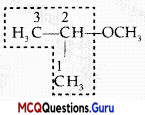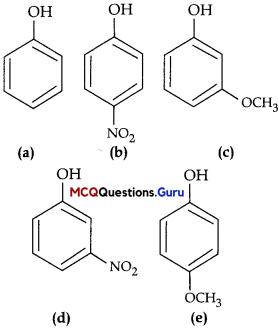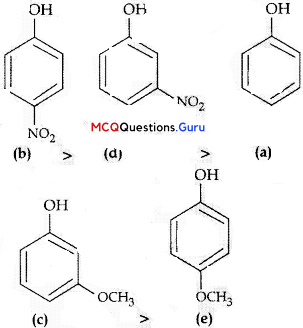Alcohols, Phenols and Ethers Class 12 MCQs Questions with Answers
Alcohol Phenol And Ether MCQ Chapter 11 Class 12 Question 1.
How many alcohols with molecular formula C4H10O are chiral in nature?
(A) 1
(B) 2
(C) 3
(D) 4
Answer:
(A) 1
Explanation:
![]()
Butan-2-ol is chiral in nature as it possesses chiral center.
Alcohol Phenol And Ether MCQ Class 12 Chapter 11 Question 2.
IUPAC name of m-cresol is ………….
(A) 3-methylphenol
(B) 3-chlorophenol
(C) 3-methoxyphenol
(D) benzene-1,3-diol
Answer:
(A) 3-methylphenol
Explanation:

(i) -OH is functional group and -CH3 is substituent.
(ii) IUPAC name : 3-methylphenol.
![]()
Alcohols Phenols And Ethers Class 12 MCQ Chapter 11 Question 3.
Phenol is less acidic than …………
(A) ethanol
(B) o-nitrophenol
(C) o-methylphenol
(D) o-methoxyphenol
Answer:
(B) o-nitrophenol
Explanation:
In o-nitrophenol, nitro group is present at ortho position. Presence of electron withdrawing group at ortho position increases the acidic strength. On the other hand, in o-methylphenol and in o-methoxyphenol electron releasing group (-CH3 or -OCH3), at ortho or para positions of phenol decreases the acidic strength of phenols. So, phenol is less acidic than o-nitrophenol.
Alcohol Phenol Ether MCQ Chapter 11 Question 4.
Which of the following species can act as the strongest base?
(A) ΘOH
(B) ΘOR
(C) ΘOC6H5

Answer:
(B) ΘOR
Explanation:
Weakest acid has the strongest conjugate base. Since R-OH is the weakest add, therefore, OR is the strongest base.
MCQ Of Alcohol Phenol And Ether Chapter 11 Question 5.
Which of the following compounds will react with sodium hydroxide solution in water?
(A) C6H5OH
(B) C6H5CH2OH
(C) (CH3)3COH
(D) C2H5OH
Answer:
(C) (CH3)3COH
Explanation:
Phenol being more acidic reacts with sodium hydroxide solution in water to give ? sodium phenoxide which is resonance stabilized.
C6H5OH + NaoH → C6H5ONa + H2O
![]()
Alcohol Phenol Ether Class 12 MCQ Chapter 11 Question 6.
Which of the following compounds is aromatic alcohol?

(A) A, B, C, D
(B) A, D
(C) B, C
(D) A
Answer:
(C) B, C
Explanation:
Compound (A) phenol and compound (D), that is, a derivative of phenol Cannot be considered as aromatic alcohol. As phenol is also known as carbolic acid and cannot be considered as aromatic alcohol. Compound (B) and (C) -OH group is bonded to Sp3 hybridized carbon which in turn is bonded to benzene ring.
MCQ On Alcohol Phenol And Ether Chapter 11 Question 7.
Give IUPAC name of the compound given below.

(A) 2 -Chloro-5-hydroxyhexane
(B) 2-Hydroxy-5-chlorohexane
(C) 5-Chlorohexan-2-ol
(D) 2-Chlorohexan-5-ol
Answer:
(C) 5-Chlorohexan-2-ol
Explanation:

Class 12 Chemistry Chapter Alcohol Phenol And Ether MCQ Question 8.
Arrange the following compounds in increasing order of boiling point. :
Propan-l-ol, butan-l-ol, butan-2-ol, pentan-l-ol
(A) Propan-l-ol, butan-2-ol, butan-l-ol, pentan-l- ol
(B) Propan-l-ol, butan-l-ol, butan-2-ol, pentan-l- ol
(C) Pentan-l-ol, butan-2-ol, butan-l-ol, propan-l- ol
(D) Pentan-l-ol, butan-l-ol, butan-2-ol, propan-l- ol
Answer:
(A) Propan-l-ol, butan-2-ol, butan-l-ol, pentan-l- ol
Explanation:
Boiling point increases with increase in molecular mass ol the alcohols. Among isomeric alcohols 1° alcohols have higher boiling point than 2° alcohols. Thus, correct order is : Propan-l-ol < Butan-2-ol Butan-l-ol pentan-l-ol
Alcohols Phenols And Ethers MCQ Chapter 11 Question 9.
Which of the following species can act as the strongest base?
(A) -OH
(B) -OR
(C) -OC6H5

Answer:
(B) -OR
Explanation:
Weakest acid has the strongest conjugate base. Since R-OH is the weakest acid, therefore, -OR is the strongest base.
![]()
MCQ Questions For Class 12 Chemistry Chapter 11 Question 10.
The IUPAC name of anisole is ………..
(A) 2-methyltoluene
(B) Methyl phenyl ether
(C) Methoxybenzene
(D) Ethoxybenzene
Answer:
(C) Methoxybenzene
Explanation:
C6H5OCH3 IUPAC name: Methoxvbenzene
Question 11.
Williamson synthesis is used to obtain
(A) Primary alcohol
(B) Ether
(C) Aldehyde
(D) Ketone
Answer:
(B) Ether
Explanation:
Williamson synthesis is used to obtain ether. For example,

Alcohol Phenol And Ether MCQ With Answers Chapter 11 Question 12.
Write the IUPAC name of the following compounds

(A) 2-Methoxy-isopropane
(B) 2-Methyl-2-methoxypropane
(C) 2-Methoxy-2-methylpropane
(D) 2-Methoxy-2,2 -dimethyl ethane
Answer:
(C) 2-Methoxy-2-methylpropane
Explanation:
2-Methnxy-2-methvlpropanc.
Longest carbon chain is taken as the parent alkane in the IUPAC nomenclature.
Class 12 Chemistry Alcohols Phenols And Ethers MCQ Question 13.
IUPAC name for the given compound is

(A) 2-ethoxy-2-methylethane.
(B) 2-propoxypropane.
(C) 2-methyl-2-ethoxypropane
(D) None of the above
Answer:
(B) 2-propoxypropane.
Explanation:
IUPAC name of the compound is 2-propoxypropane.
Alcohol MCQ Class 12 Chapter 11 Question 14.
Bond angle in ethers is slightly less than
(A) Square planar angle
(B) Tngonal bipyramidal angle
(C) Tetrahedral angle
(D) None of the above
Answer:
(C) Tetrahedral angle
Explanation:
Bond angle in ether is slightly more than the tetrahedral angle due to repulsionbetween the two bulky alkyl groups.
![]()
MCQ Questions On Alcohol Phenol And Ether Chapter 11 Question 15.
IUPAC name of the compound  is ………….
is ………….
(A) 1-methoxy-1-methylethane
(B) 2-methoxy-2-methylethane
(C) 2-methoxypropane
(D) isopropylnwthyl ether
Answer:
(C) 2-methoxypropane
Explanation:

Assertion And Reason Based MCQs
Directions: In the following questions, A statement of Assertion (A) is followed by a statement of Reason (R). Mark the correct choice as.
(A) Both A and R are true and R is the correct explanation of A
(B) Both A and R are true but R is NOT the correct explanation of A
(C) A is true but R is false
(D) A is false and R is True
Class 12 Alcohols Phenols And Ethers MCQ Chapter 11 Question 1.
Assertion (A): Ortho and para-nitrophenol can be separated by steam distillation.
Reason (R): Ortho isomer associates through intermolecular hydrogen bonding while para isomer associates through intermolecular hydrogen bonding.
Answer:
(C) A is true but R is false
Explanation:
Ortho isomer has intermolecular H-honding while para isomer has intermolecular hydrogen bonding.
MCQ Alcohol Phenol And Ether Chapter 11 Question 2.
Assertion (A): (CH3)3C-0-CH3 gives (CH3)3C-I and CHOH on treatment with HI.
Reason (R): The reaction occurs by SN1 mechanism.
Answer:
(A) Both A and R are true and R is the correct explanation of A
Explanation:
(CH3)3C-O-CH- gives (CH-C-H) and CH,OH on treatment with HI. The reaction occurs by SN1 mechanism.
Class 12 Alcohol Phenol And Ether MCQ Chapter 11 Question 3.
Assertion (A): Carboxylic acids are more acidic than phenols.
Reason (R): Phenols are ortho and para directing.
Answer:
(B) Both A and R are true but R is NOT the correct explanation of A
Explanation:
Carboxylic acids are more acidic than phenols as the carboxylate ion, the conjugate base of carboxylic acid is stabilized by two equivalent resonance structures.Thus, the negative charge is delocalized effectively. However, in phenols, negative charge is less effectively delocalized over oxygen atom and carbon atoms in phenoxide ion.

MCQs On Alcohols Phenols And Ethers Chapter 11 Question 4.
Assertion (A): Ethers behave as bases in the presence of mineral acids.
Reason (R): In ethers, oxygen consists of lone pair of electrons.
Answer:
(A) Both A and R are true and R is the correct explanation of A
Explanation:
Ethers behave as bases in the presence of mineral acids like HCl due to presence of lone pair of electrons on oxygen atom and form stable oxonium salts with mineral acids.

Alcohol Phenol And Ether Class 12 MCQ Chapter 11 Question 5.
Assertion (A) : The C-O-C bond angle in ethers is slightly less than tetrahedral angle.
Reason (R): Due to the repulsive interaction between the two alkyl groups in ethers.
Answer:
(D) A is false and R is True
Explanation:
The C-O-C bond angle in ether is slightly greater than tetrahedral angle. It is due to the repulsive interaction between the two alkyl groups in ethers.
![]()
Alcohol Ether And Phenol MCQ Chapter 11 Question 6.
Assertion (A): Methoxy ethane reacts with HI to give ethanol and iodomethane.
Reason (R): Reaction of ether with HI follows \(\mathrm{S}_{\mathrm{N}} 2\) mechanism.
Answer:
(A) Both A and R are true and R is the correct explanation of A
Explanation:
Vlelhoxv ethane reacts with HI to give ethanol and iodomethane. Reaction of ether with HI follows \(\mathrm{S}_{\mathrm{N}} 2\) mechanism.
Case-Based MCQs
I. Read the passage given below and answer the following questions:
Alcohols are versatile compounds. They act both as nucleophiles and electrophiles. The bond between O-H is broken when alcohols act as nucleophiles.
(i) Alcohols as nucleophiles

(ii) The bond between C-O is broken when they act as, electrophiles. Protonated alcohols react in this manner.
Protonated alcohols as electrophiles
R-CH2-OH+H → R-CH2+OH2 Based on the cleavage of O-H and C-O bonds, the reaction of alcohols and phenols may be divided into two groups:
(a) Reactions involving cleavage of O-H bond
(b) Reactions involving cleavage of C-O bond
Acidity of alcohols and phenols
(i) Reaction with metals:
Alcohols and phenols react with active metals such as sodium, potassium and aluminium to yield corresponding alkoxide/ phenoxides and hydrogen.

Question 1.
Write down the decreasing order of reactivity of sodium metal towards primary, secondary and tertiary alcohols.
(A) 1°alc < 2°alc < 3°alc (B) 1°alc > 2°alc > 3°alc
(C) 3°alc <1°alc < 2°alc (D) 3°alc > 1°alc < 2°alc°
Answer:
(B) 1°alc > 2°alc > 3°alc
Explanation:
Na mclal is basic and alcohols are acidic in nature. Hence, reactivity of a metal towards alcohols decreases as the acidic strength if of alcohols decreases due to steric hinderancei Jot alkyl groups in tertiary alcohol and increase in electron density on an oxvgen atom in the hydroxyl bond.
Question 2.
Name of the following reaction:

(A) Williamson’s synthesis
(B) Kolbe’s reaction
(C) Reimer-Tiemann reaction
(D) Sandmeyer’s reaction
Answer:
(C) Reimer-Tiemann reaction
Question 3.
Given the descending order of acid strength of alcohols.
(A) RCH2OH > RR’CHOH >> RR’R”COH
(B) RCH2OH > RR’R”COH > RR’CHOH
(C) RCH2OH < RR’CHOH < < RR’R”COH
(D) RCH2OH < RR’R”COH < RR’CHOH Answer: (A) RCH2OH > RR’CHOH >> RR’R”COH
Explanation:
The more stable the alkoxide ion, the more acidic is the alcohol. Electron releasing effect (+I effect ) of alkyl group in secondary and tertiary alcohols makes the alkoxide ion less stable.
![]()
Question 4.
Write the IUPAC name of the following compound:

(A) 2-methyl, 2-phenyl ethanol
(B) 2-phenyl butanol
(C) 2-Phenylopropan-2-ol
(D) 1-methyl, 1-phenyl ethanol
Answer:
(C) 2-Phenylopropan-2-ol
Explanation:

IUPAC name = 2-Phenylpropan-2-ol
II. Read the passage given below and answer the following questions:
Oxidation of alcohols involves the formation of a carbon-oxygen double bond with cleavage of an O-H and C-H bonds.

Such a cleavage and formation of bonds occur in oxidation reactions. These are also known as dehydrogenation reactions as these involve loss of dihydrogen from an alcohol molecule. Depending on the oxidising agent used, a primary alcohol is oxidised to an aldehyde which in turn is oxidised to a carboxylic acid. Strong oxidising agents such as acidified potassium permanganate are used for getting carboxylic acids from alcohols directly. CrO3 in anhydrous medium is used as the oxidising agent for the isolation of aldehydes.
In these questions a statement of assertion followed by a statement of reason is given. Choose the correct answer out of the following choices.
(A) Assertion and reason both are correct statements and reason is correct explanation for assertion.
(B) Assertion and reason both are correct statements but reason is not correct explanation for assertion.
(C) Assertion is correct statement but reason is wrong statement.
(D) Assertion is wrong statement but reason is correct statement
Question 1.
Assertion (A): Dehydrogenation reaction of alcohols is an oxidising reaction.
Reason (R): It involves loss of dihydrogen from alcohol.
Answer:
(A) Assertion and reason both are correct statements and reason is correct explanation for assertion.
Explanation:
Dehydrogenation means loss of dihydrogen from a molecule.
Question 2.
Assertion (A): CH3CH2OH can be converted into CH3CHO by treatment with pyridinium chlorochr ornate.
Reason (R): PCC is a better reagent for oxidation of primary alcohols to aldehydes.
Answer:
(A) Assertion and reason both are correct statements and reason is correct explanation for assertion.
Explanation:
PCC (Pyridinium chlorochromate) ( is a better reagent for converting ethyl alcohol into acetaldehyde.
Question 3.
Assertion (A): Tertiary alcohols do not undergo oxidation reactions.
Reason (R): They do not have the required C-H bond.
Answer:
(A) Assertion and reason both are correct statements and reason is correct explanation for assertion.
Explanation:
iertiarv alcohols do not undergo oxidation reactions because the carbon atom that carries the -OH group does not have a hydrogen atom.
![]()
Question 4.
Assertion (A): Vapours of primary and secondary alcohols are passed through heated copper an aldehyde and ketone are formed.
Reason (R): It’s a dehydration reaction.
Answer:
(C) Assertion is correct statement but reason is wrong statement.
Explanation:
Vapours of primary and secondary alcohols are passed through heated copper and aldehyde and ketone are formed. It’s a dehydrogenation reaction. The presence of electron-withdrawing group viz. -NO, group increases the acidity of phenol due to -I effect and electron releasing group viz. -OCH. group decreases the acidity of phenol due to the +1 effect. Moreover, p-nitrophenol is more acidic than m-nitrophenol. While p-methoxy phenol is less acidic than m-methoxy phenol.
III. Read the passage given below and answer the following questions:
The reaction of phenol with aqueous sodium hydroxide indicates that phenols are stronger acids than alcohols and water, Due to the higher electronegativity of sp2 hybridised carbon of phenol to which -OH is attached, electron density decreases on oxygen.
This increases the polarity of the O-H bond and results in an increase in ionisation of phenols than that of alcohols. Now let us examine the stabilities of alkoxide and phenoxide ions. In alkoxide ion, the negative charge is localised on oxygen while in phenoxide ion, the charge is delocalised. The delocalisation of negative charge makes phenoxide ions more stable and favours the ionisation of phenol.
Question 1.
Phenol is Less acidic than
(A) ethanol
(B) o-nitrophenol
(C) o-methyl phenol
(D) o-methoxy phenol
Answer:
(B) o-nitrophenol
Explanation:
Phenol is less acidic than o-nitrophenol as the electron-withdrawing (-NO2) group increases the acidity of phenols.
Question 2.
Which of the following is most acidic?
(A) Benzyl alcohol
(B) Cyclohexanol
(C) Phenol
(D) m-Chlorophenol
Answer:
(D) m-Chlorophenol
Explanation:
m-chlorophenol is most acidic as electron-withdrawing (-Cl)group increases the acidity of phenols.
Question 3.
Mark the correct order of decreasing acid strength of the following compounds.

(A) e > d > b > a > c
(B) b > d > a > c > e
(C) d > e > c> b> a
(D) e > d > c> b> a
Answer:
(B) b > d > a > c > e
Explanation:

The presence of electron withdrawing group viz. -NO2 group increases the acidity of phenol due to -I effect and electron releasing group viz. -OCH3 group decreases the acidity of phenol due to +1 effect. Moreover, p-nitrophenol is more acidic than m-nitrophenol. While, p-methoxyphenol is less acidic than m-methoxyphenol.
Question 4.
Phenol can be distinguished from ethanol by the reaction with
(A) Br2/water
(B) Na
(C) Glycerol
(D) All of the above E
Answer:
(A) Br2/water
Explanation:
Phenol decolourises bromine water to form while precipitate of 2,4,-tribromophenol whereas ethanol does not precipitate.